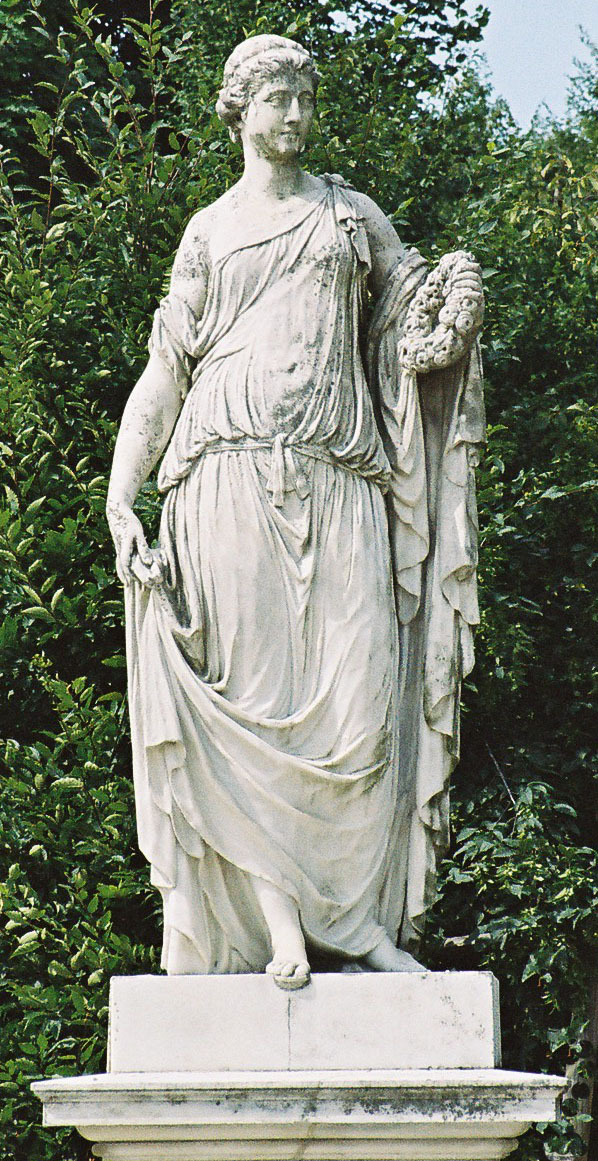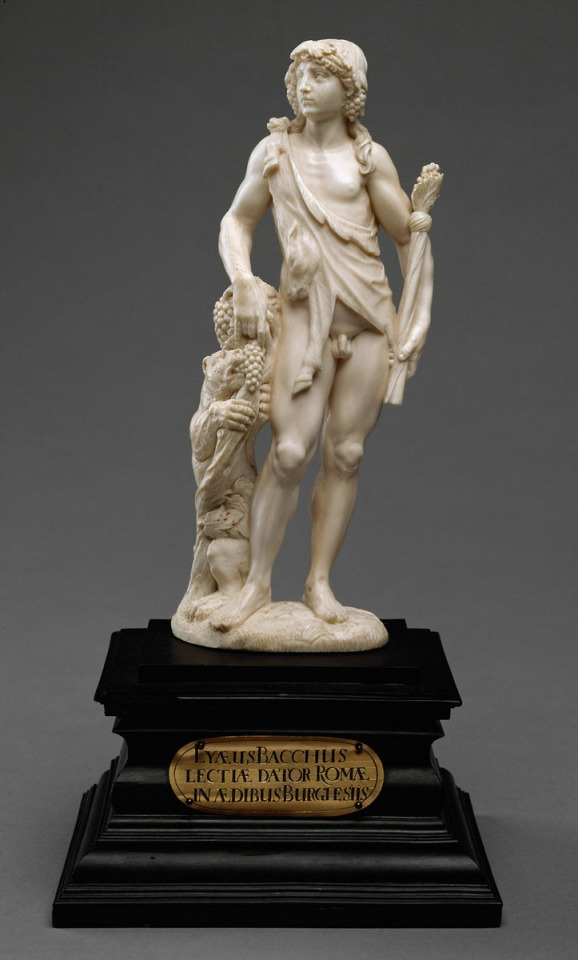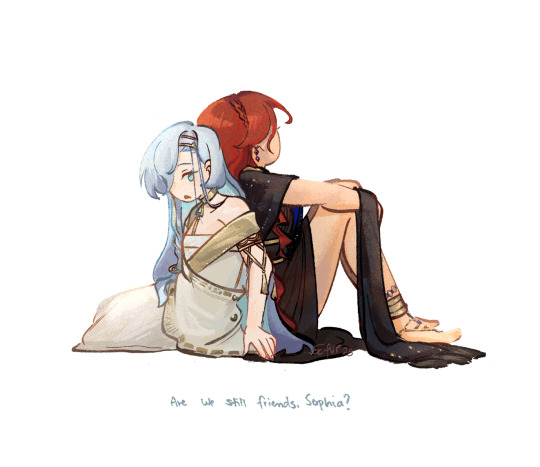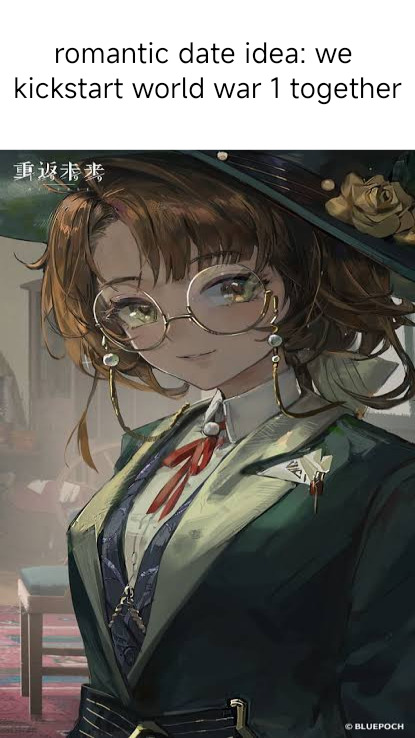r1999 blog. idk anything about anything, all I have is chronic illness, Wikipedia and a dream.
Don't wanna be here? Send us removal request.
Text
Reverse 1999 3.0 spoilers warning.
Sentinel’s design and the clothing crisis of the French Infantry during WW1.

This is not going to be a real analysis of her design because I don’t know enough about WW1, the army, or her, but I fell into a bunch of rabbit holes in a row so I need to give this knowledge a purpose now lol.
I didn’t source this because most of it is in French but hopefully it won’t be too inaccurate. I tried.
Ignoring her Batman boots because hell yeah, what really struck me about her design was the white pants. I don’t know how well known this is outside of France but the pants the infantrymen wore during World War One sort of reached urban legend status. The uniforms did change quite a bit during the war but the pants were never white, so I’m not quite sure why they chose to dress her like that.
Maybe this will end up being meaningful, like maybe she’s part of a special arcanist regiment I don’t know, or perhaps it’s just meant to make her stand out a little more. But this might be relevant context for the story in any case, so here’s the story of how a pair of pants allegedly killed a bunch of people during the war.
Historically French infantrymen went into WW1 looking a lot bolder.
the garance uniform (1829-1915)

For a very long time, flashy colors were preferred for military uniforms so soldiers would have an easier time spotting each other in the midst of battle, especially because gunpowder smoke was causing such big vision issues.
There was also a social aspect, so much so that when smokeless powder was created at the end of the 19th century and most European armies subsequently got into camouflage, the French very much! Did not!
Or more like, they debated about it, like a lot. They had first become aware of the anachronism of the uniform at the very beginning of the 20th century during the Second Boer War (1899-1902), where the British troops debuted khaki uniforms, which advantaged them greatly. (And though that’s what I’m focusing on because of R1999, I need to clarify that there were more issues than just the fucking pants lmao.)
The debates lasted for over 10 years, with several unsuccessful design attempts and much much social backlash. They notably almost managed to change it to green in 1911 thanks to a particularly motivated Minister of War, but unfortunately a plane crash-landed on his head and he died.
Part of the difficulty here was that it had become a public debate. A former minister even declared "Get rid of the red pants? Never, the red pants *are* France." And as WW1 was drawing closer and closer, people became very into the idea of getting revenge against the Germans for the War of 1870 while wearing the national colors. Nevermind that the red dye in question was apparently produced in Germany of all places.
This is an example of the "attaque à outrance" (attack at excess) military mindset that was very much still prevalent in Europe at the time. Also called "cult of the offensive", it was based on this idea that willpower was the strongest component of a military victory and henceforth, rushing onto the enemy was preferable to defensive strategies. I’m not going to get into the obvious propaganda of it all, but let’s just say that wearing your literal flag is certainly related. Back then, the uniform seems to have been used as a fashion statement meant to glorify the soldier’s patriotism and masculinity.
Eventually, a decree was finally signed in July 1914 to give up on "l’uniforme garance" (the name of the red dye). At the end of the month, on July, 28th 1914, the First World War would break out.
It would take over a year for the new uniforms to be both produced and fully distributed among the French troops. The garance uniform is quoted to have caused the deaths of thousands of French soldiers in the early phase of the Great War, both because its impracticality and sheer visibility.
I must clarify here that the pants are but one example of how WW1 forcibly transformed international warfare, and how industrialized weaponry defeated the cult of the offensive. Unfortunately I do not know jackshit about war so I will not elaborate, but there were many more mistakes made at the time, this is just one of the more striking one.
the horizon blue uniform (1915-1921)


At first, they had decided to mix blue, white and red (national colors) threads to continue the patriotic trend but ended up picking this grey-blue color instead, because it was a lot more efficient to make, and all of the other neutral tones had apparently already been picked by other countries.
I should mention here that though this was a stark improvement from the previous uniform, its camouflage properties were heavily criticized both during and after the war, especially when compared to the muddier tones of other armies. So much so that by the end of the war the Germans had apparently developed special technology to be able to spot the blue horizon even easier.
ANYWAY, that’s the uniform the NPCs seem to be wearing in Sentinel’s trailer. It’s the color most associated with the figure of the "poilus" (hairy ones), a term of endearment for the WW1 French infantrymen. Not that they were particularly hairy, especially since they had to shave to wear gas masks, but it appears to have originated as an expression of rustic everyday masculinity.
Sentinel is dressed quite differently here however. Her i1 uniform is pretty unmistakably blue horizon, but this one is a lot darker. I believe this is her i2 outfit since it’s also on her splash art. It’s too early to say what it’s supposed to be exactly, but darker blue was most common amongst higher ranking officers. This could make sense but her trailer names her as a second class soldier so I really don’t think this is why. It could be one I just haven’t found in my research, but my money is on the arcanist regiment because that sounds just like something they would write.
All in all, none of this explains why her pants are fucking white in both outfits. I really did look but I didn’t found anything that would make sense in this context. It probably does not matter at all, it’s certainly just a stylistic choice, but I am invested now I hope this is lore lmfao.
#reverse 1999#r1999#my post#I don’t actually care that much I was just possessed by the demon of knowledge for like 10h straight#I almost translated a very bad poem about this fuck ass uniform because it was… a lot. but ended up not because. it was. a lot.#by edmond rostand from cyrano de bergerac fame
42 notes
·
View notes
Text
Now that Aleph has been released on Global and people have (hopefully) had the chance to read both Chapter 9 and his character story, I want to send an Aleph analysis I co-authored with a mutual of mine on Twitter back when 2.6 first came out on CN.
MASSIVE SPOILER WARNING FOR 2.6 AND ALEPH'S STORY. PLEASE READ THOSE FIRST BEFORE TAKING A LOOK AT THIS ANALYSIS
35 notes
·
View notes
Text

magma server updating while we were drawing *clenches fist of rage*
169 notes
·
View notes
Text
Throwback to this piece from 2023(4?), it still has a soft spot in my heart

43 notes
·
View notes
Text
The statues in Apeiron's Hall of Truth are real statues
In Apeiron's Hall of Truth, there are 5 sculptures that are laid out along the walls of the room. While looking around, I found that the statues happened to be ones you happen to find in real life.

I was able to identify 3 of the 5 sculptures, but the two statues on the far left are currently left unidentified since it was too dark to be able to image search them properly.
Though, I want to focus on the sculptures that I was able to find information on. Let's get started.



These 3 statues were identified to be statues from the Schönbrunn Garden, a palace garden located in Vienna, Austria (surprising, I know). In the Great Parterre area of the garden, there are 32 statues depicting various Greco-Roman mythological deities and virtues. These 3 are no different.
Asclepius, Greek God of Healing and Medicine (Veit Königer)


Asclepius is most known for the rod that he holds, wrapped by a snake (a sacred animal who held wisdom, healing, and resurrection) who granted him secret knowledge in exchange of kindness. The rod—similar to Hermes' caduceus by design—is the most iconic and used symbol for medicine and healing today.
Gaius Mucius Scaevola, Roman Youth Figure (Johann Martin Fischer)


Mucius here is most known for his willpower during the Roman-Etruscan wars. "Scaevola" is a term/cognomen that means "left-handed." The name was given to Mucius after he willingly placed his right hand over an open flame when he was held captive by Clusian King Lars Porsena.
Porsena let him go after finding that the young man (and by extension, the young Romans) was more than willing to hurt himself if it meant that Rome would reign victorious over Clusium.
Flora, Roman God of Spring and Flowers (Johann Wilhelm Beyer)


She was a well-celebrated minor goddess in Roman mythology, and was also one of the many deities that signified youth and fertility given the nature of springtime. The Floralia is a ancient Roman festival that celebrated Flora with drinking, flowers, and entertainments. She has a temple that was established in 238 BCE.
Note: At one point, I mistook the statue for the Flora Farnese, one of the many statues part of the collection of Cardinal Alessandro Farnese (later Pope Paul III). I found that Flora had her own statue in the gardens as well a bit later.
The Unidentified Sculptures
There are two other sculptures that are currently left unidentified because the area was too dark and thus leaving too much room for pixelation of the images when it came to cropping them.


There are a couple of notes that can be considered if you wish to find them:
The first sculpture has a beard, and holds the cloth wrapped around his waist. The cloth also seeps to be wrapped around his shoulder.
The second statue is of a clean-shaven man with very loose clothing. He has his right arm raised while also having an animal by his side.
Neither of them are sculptures from the garden. Trust me, I already went through each image of the article more than once.

Here's the sculptures but under a brighter light despite there being less details.
A close match I could get from the second statue would be that of Bacchus by Georg Pfründt, but it's not quite as close as I'd like it to be.

Anyways, these are just some observations I wanted to note down. I spent way too many hours trying to find the two statues above. Thanks for reading and have fun if you want to try to search for the other two statues.
36 notes
·
View notes
Text
Oliver Fog’s profile kind of implies that his father died during the Great Fog of London, or at least that’s what I always understood from it. That he just disappeared in the fog.
But going through the Daily Records, I found out that Arthur actually survived, just to die two weeks later from the health complications that resulted from it.


He died on Christmas Eve 🥲
12 notes
·
View notes
Text

rip schneider you would've loved HEALTH
400 notes
·
View notes
Text

attempted disco elysium inspired portraits with the disaster siblings
107 notes
·
View notes
Text

it's a bit chilly
129 notes
·
View notes









